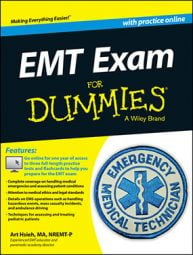Hidden injuries are always a concern for an EMT. After you can distinguish different types of MOIs, you can match up different areas of the body to possible injury patterns. Here’s an overview of possible injuries. Obvious injuries are those you can see; hidden injuries are ones that require assessment and an understanding of MOI.
| Body Area | Obvious Injuries | Hidden Injuries |
|---|---|---|
| Head and face | Contusions; abrasions; lacerations; punctures; avulsions; burns; lost or fractured teeth; blow-out eye fractures; foreign bodies; bleeding from eyes, nose, and ears | Epidural hematoma, subdural hematoma, intracranial hematoma, intracranial pressure (ICP), concussion, skull fracture, upper airway swelling |
| Neck | Contusions, abrasions, lacerations, punctures, avulsions, burns, open neck wounds, cervical spine deformity | Upper airway swelling, soft-tissue bleeding in larynx, subcutaneous emphysema, fractured larynx, cervical spinal cord injury |
| Anterior chest | Contusions, abrasions, lacerations, punctures, avulsions, burns, open wounds | Pneumothorax (simple and tension); hemothorax; pulmonary contusion; cardiac contusion; commotio cordis; large vessel lacerations; flail chest; rib fractures; traumatic asphyxia; liver, spleen, and upper GI trauma |
| Anterior abdomen | Contusions, abrasions, lacerations, punctures, avulsions, burns, open wounds, evisceration | Solid organs that bleed (liver, spleen, pancreas, ovaries); hollow organs that rupture (intestines, stomach); mesentery bleeding; pregnancy-related trauma |
| Pelvis | Contusions, abrasions, lacerations, punctures, avulsions, dislocated hip, proximal femur fractures, genital injuries | Unstable pelvic fracture, bladder and urinary tract injuries, genital injuries (uterus) |
| Extremities | Contusions, abrasions, lacerations, punctures, avulsions, long bone fractures, dislocations, sprains, strains, amputations | Compartment syndrome, interstitial bleeding, loss of perfusion |
| Back | Contusions, abrasions, lacerations, punctures, avulsions, spinal deformity, open posterior chest wound | Spinal cord injury, scapula/rib fractures, kidney injury, bleeding into the retroperitoneal space |
You probably notice that soft-tissue injuries are common to all areas of the body. Don’t let these obvious ones blind you to the more serious injuries that are below the skin’s surface. Consider the obvious injuries as “road signs” that can point to further problems behind them.
Trauma-related exam questions may ask about which injury you should manage first. Look at all the responses and ask yourself which one is likely to be most harmful as opposed to most dramatic. Check out the following example.
A 24-year-old unrestrained driver was involved in a rollover crash of his van. He is lying unconscious outside of the vehicle. He has a deformed left lower leg, swelling in his right thigh, and abrasions across his chest and forehead. His pupils are unequal, he is breathing at 6 times per minute, and his pulse rate is 50. Which of the following actions should you perform first?
(A)Apply a cardboard splint to the lower leg deformity.
(B)Ventilate the patient at 20 breaths per minute with a bag-valve mask and oxygen.
(C)Apply a traction splint to the right thigh.
(D)Administer high-flow oxygen via a nonrebreather mask.
The best choice is (B). Although the lower left leg deformity, Choice (A), and the swelling in the right femur region, Choice (C), may be significant and obvious, the slow respiratory and heart rates, along with the abrasion to the forehead and unequal pupils, indicate the probability of a hidden brain injury that requires immediate attention. The patient is breathing too slowly for supplemental oxygen only, as Choice (D) suggests.

